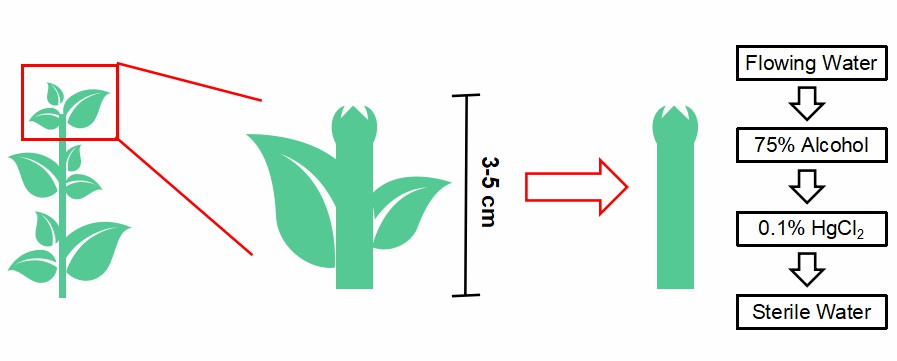 MEET US AT PLANT BIOLOGY 2024 June 22-26, 2024 Honolulu, Hl #309Learn More
MEET US AT PLANT BIOLOGY 2024 June 22-26, 2024 Honolulu, Hl #309Learn More
Plants grown in their natural environment carry a wide range of viruses and this has caused huge economic losses. It is generally believed that in stem tip micro stems, the vascular system is not well developed and viruses can only be transferred between cells via the small number of plasmodesmata that have just formed. Therefore, the rate of virus transmission in the apical micro stem is very slow and the chances of obtaining virus-free seedlings after plant tissue culture are high.
The virus is not uniformly distributed in the plant, the closer it is to the growing point (0.1-1 mm area) the more dilute the virus concentration is, therefore it is possible to remove the virus from the plant by using small stem tip in vitro cultures.
Healthy plants with light disease susceptibility and low virulence should be selected as explant material for detoxification, so that it is easier to obtain virus-free strains. Terminal bud tip segments were taken from selected plants for sterilization and inoculation. The terminal bud tip segments were taken 3-5 cm, stripped of the large leaves, rinsed with flowing water, then disinfected with 75% alcohol for about 30 s, 0.1% mercuric chloride for 10 min, and finally rinsed with sterile water 4-5 times.
 Fig 1. The procedures of material selection and sterilization
Fig 1. The procedures of material selection and sterilization
In an ultra-clean bench and under the observation of an 8-40 x dissecting microscope, carefully peel off the young leaves with a scalpel (needle) until the growth point is exposed, cut off the growth point with 1-2 leaf primordia with the tip of the scalpel, and transfer the cut stem tip to the differentiation medium. The size of stem tip explants is inversely related to the detoxification effect, i.e. the smaller the stem tip, the better the detoxification effect. However, the size of the stem tip is positively correlated with the survival rate of the stem tip, i.e. the smaller the stem tip is, the more difficult it is to culture and the lower the survival rate. In general, it is more suitable to cut 0.2-0.5mm stem tip explants with 1-2 leaf primordia. When stripping the stem tip, it should be inoculated as soon as possible, because the stem tip should be exposed for as short a time as possible to prevent it from drying out.
 Fig 2. The procedures of stripping stem tips and inoculation
Fig 2. The procedures of stripping stem tips and inoculation
The inoculated material was incubated at (25±2)°C with 10-16 h of light per day. Green shoots could be regenerated from the stem tip in about 2 months, during which time the medium should be replaced with new medium periodically.
Some plants produce adventitious roots quickly at the base of the stem tip culture after forming green shoots, while others do not produce adventitious roots and must be transferred to rooting medium for rootless seedlings to produce adventitious roots and become complete plants. Sufficient test seedlings need to be obtained by subculture for virus detection.
 Fig 3. The procedures of culture and induction of rooting
Fig 3. The procedures of culture and induction of rooting